A guide for understanding Candlestick charts as important analysis tool
As technical analysts, it is our goal to form a view regarding whether a particular share is going up, going down, or moving in a sideways band. Even though there are only three directions in which a share can move, it is sometimes a tricky task to see exactly what a share is doing. Simplicity is essential. When first looking at a chart, get to the grass roots level and have a good look at a share’s price action. You can use a bar chart, a line chart or a candlestick chart.
The markets are made up of people’s emotions towards shares. If they predominantly feel fear that they will lose their capital or profits, then the share price will ultimately decrease. If the participants mainly feel greed or hope, the share price will go up. A chart will show this interplay of emotion in a graphic format.
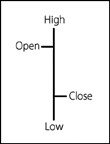
A single Western bar
The individual building block of a bar chart is a single bar. Drawing a single bar requires an opening price, a high, a low and a closing price.The vertical line shows the high and low of that period. The two horizontal lines depict the open and the close. The open is the horizontal line on the left of the vertical line, and the close is the horizontal line on the right of the vertical line. On a daily chart, one bar will show the share price action for one day. If you look at a weekly chart, the open price will be the opening price at the start of the week and the closing price will be the final price recorded at the end of the week. The high and low will be the overall high for the week and the overall low for the week. Whichever time period you utilise, the bar can show the activity for that session.
When many of these single period bars are plotted on a chart, with the horizontal axis representing time and the vertical axis showing the share price, a traditional bar chart is created.
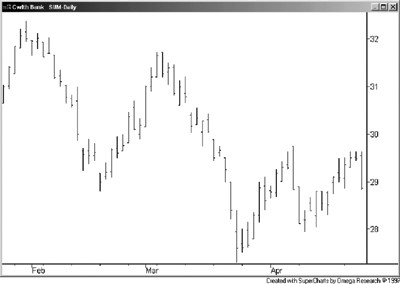
CBA daily bar chart
The interrelationships of the bars show whether the share is generally going up in value (that is, bullish) or going down in value (that is, bearish). Periods of sideways progression are also evident. Indicators may help assist you to understand whether the predominant direction is likely to continue.
A line chart connects the closing prices for each period, and so provides even less information, but is perhaps a simpler chart to interpret in comparison to the bar chart.
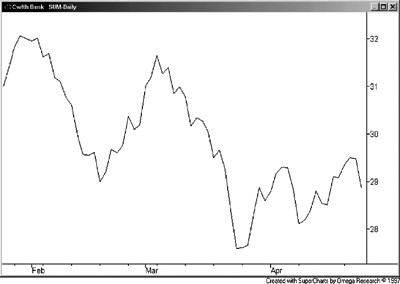
CBA daily line chart
This type of chart is generally used in newspapers when a journalist depicts share price action.
A single candlestick represents the same data that you will find in a single bar, however, the two look completely different. The origin of the name is obvious when looking at the chart. A candlestick chart looks like a series of candles with tails at either end of the candle. Every part of the candle has specific implications.
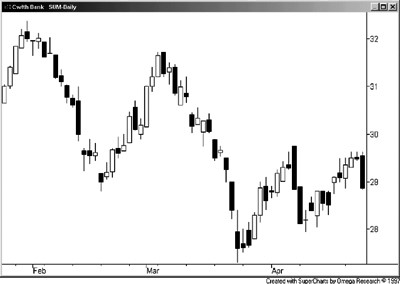
daily candlestick chart
The these three charts in all represent the same information, and the same time scale, yet their graphical format ensures that each chart looks very different.
Why Use Candles Instead Of Bars?
There is a silent war going on between two distinct groups of technical analysts—bar chartists and candlestick chartists. Which is the best type of chart to use for your needs? Let’s rate them according to the following dimensions.
Colour
Bar charts usually show up in boring black. This is hardly adventurous, is it? Such an unimaginative monochrome! Red and green (or black and white) are much more exciting to look at than a boring one-colour depiction of share price action. The colours of the candles instantly epitomise bullish or bearish intent and will let you see at a glance whether the trend is moving up or down, even from the back of an auditorium. This clarity is essential during periods of trading pressure. Candles clearly win on the ‘colour’ dimension.
Number of patterns
An advantage of the candlestick chart is the variety of reversal and continuation patterns these charts reveal. The majority of these patterns are unique to candlestick charting and are not available by using any other method. Whilst bar charts do provide some recognisable patterns, using candlesticks will provide a greater number of triggers into positions, and, if you are using them to exit, they provide many more indications of trend completion. Again, in this category, candlesticks clearly outperform the bar chart.
If you develop an understanding of the psychological principles which drive the creation of a candlestick, you will be more likely to understand its potential impact.
Psychology
If you develop an understanding of the psychological principles which drive the creation of a candlestick, you will be more likely to understand its potential impact. This skill can be applied to any new candlestick pattern that you may come across in the future. The psychology of the candle is simpler to conceptualise and see because of the immediately apparent size of the real body and the colour of the candlesticks. Bars just aren’t as easy to read.
Visual appearance
The visual display of a candlestick chart provides a valuable method of analysing price information. As you attune your eye to candlestick patterns, signals will practically jump off the chart and wrestle you to the ground. All of the information in a standard bar chart is already included in a candle chart; it is just represented in a different format.
Interesting names
Would you prefer to talk about an ‘outside day’ (a bar chart pattern) or ‘a bullish engulfing pattern above an open window’? Candles have cool names that make them an interesting alternative to the mostly anonymous bar pattern. The specific names of a candlestick pattern will help you speak with clarity to other traders familiar with these charts. The names of the patterns are steeped in Japanese history and will quite likely increase your IQ a few percentage points, just by uttering them!
How To Read Candlestick Charts
The thick part of the candle is called the ‘real body’. This shows the range between the opening and the closing price. When the real body is white (or empty), it means that the close was higher than the opening price. When the real body is black (or filled in), the close was lower than the opening price. As you can imagine, if a share price is driven up for the day, this is a bullish sign, and results in the creation of a white candle. A share price that decreases during the day is a sign that the bears have been in control, which results in the creation of a black candle.
The thin lines above and below the real body are called the ‘wicks’, ‘tails’ or the ‘shadows’ of the candle (regardless of which side of the real body they are located). The upper tail (the high for the day on a daily chart) is located above the candlestick’s real body, and the lower tail (the low for the day on a daily chart) is located below the real body. The tails are usually seen to be of less importance than the real body, as they represent extraneous price fluctuations. The open and the close are considered to be the most emotionally charged points of the day and therefore contain the highest level of significance in candlestick analysis.
Definition of a candlestick
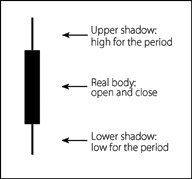
There is a saying that ‘the amateurs open the market and the professionals close the market’. The amateurs have had all night to absorb the rumours and news items about certain shares, and their anxious flurry of activity on the opening of the market reflects this. In the first hour of trading, there is a scramble of punters trying to establish their positions. Once the early morning activity calms down, the market settles into a less volatile period during the middle of the day.
The final hour of the financial markets also experiences a definite increase in volatility as buyers and sellers review the price action that occurred during the day. They must quickly assess whether they can live with their trading decisions overnight, so they must be decisive and brave to buy or sell at the final hour. Emotions again run high as traders buy and sell their shares in accordance with their view of the direction of the market for the following day.
The white candle
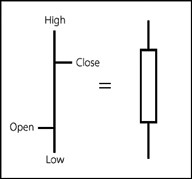
As I mentioned earlier, the colour of the candle depicts whether it is bearish or bullish. When the day closes higher than it opened, this is a positive bullish sign. There is demand for the share and buyers are willing to pay higher and higher prices. The price is driven up as demand outstrips supply.
The black candle
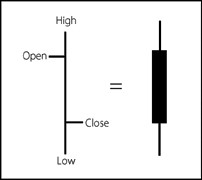
When the day closes lower than its opening price, it is a sign that sellers have fear in their hearts. This has the effect of driving the share price down. The market sentiment is pessimistic, creating a far greater supply of shares. Therefore, the close is lower than the opening price, and the colour of the candle is black. A black candle clearly shows that the bears were in control for that period.
The bulls’ and the bears’ (buyers’ and sellers’) struggle for dominance forms the basis for each candlestick pattern formation. A single candlestick, or a group of candles, often has particular bullish or bearish significance.Some common candlestick patterns
1) The shooting star
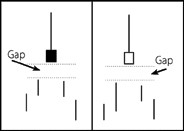
This
pattern displays an upper tail length that is two times the length of
the real body. When a gap (or a hole in the share price action) is
present between the previous candle and the shooting star,
the formation becomes more significant. This principle applies to all
candlestick patterns. This pattern, as with all top reversal candlestick
formations, has greater significance if it is black. Shooting stars
appear at the top of a trend and signify that the bears are likely to
move in with strength and that a downtrend could occur.
The small bars before and after the candlestick formation will show you the direction of the preceding and following prices on the chart. They have no other special significance in these examples.
2) The doji
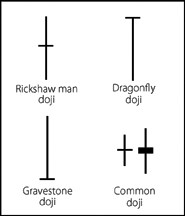
The doji displays an extremely small real body. The open and close are at the same price (or nearly at the same price) for that period. A doji is representative of the market temporarily coming to an agreement about the fair value of the share. The reason for the awesome strength of the doji is the psychological importance of its message. A doji suggests a balance of supply and demand, whereas trends require imbalance. Either the bulls or the bears must actively drive the market for a trend to endure. The doji signifies the end of one trend and the beginning of another. The share will typically reverse its direction the day after a doji appears in the chart of an uptrending or downtrending stock.
3) The spinning top
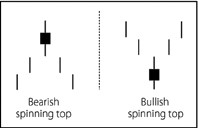
Spinning tops are similar to a doji pattern, as they both display a small real body. The real body in a spinning top formation depicts a greater range from the open to the close in comparison to a doji pattern. The tail length is largely unimportant and the candle can be either white or black. This pattern represents a tug of war between bulls and bears and is accentuated by the presence of a gap before and after its formation.
4) Hammers and the hanging man
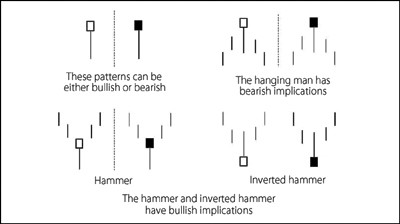
These patterns display a long tail above or below their real bodies. There is likely to be no tail, or a very short tail, on the other side of the real body. The tail length is required to be two times the length of the real body to fulfil the exact definition of this candle. Gaps increase the significance of the pattern. Look for these patterns at the top or bottom of trends to signify that a reversal is likely.
5) The bearish engulfing pattern
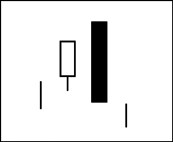
This two-candle combination is an extremely effective pattern that often signifies the dramatic end of an uptrend. After the appearance of this pattern, prices typically plunge downwards steeply. The second real body of this pattern totally engulfs the first real body and is a bearish sign, as the price has closed lower than it opened for that period. The first candle must be white, and the second candle must be black.
6) The bullish engulfing pattern
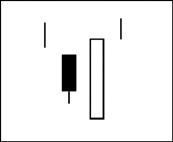
This candle pattern often signifies the end of a downtrend. After the pattern has been formed, prices often surge upwards. The colour of the first candle must be black, while the second candle must be white. If the second candle is accompanied by high relative volume, this is a particularly bullish sign. As with any bottom reversal pattern, the presence of heavy relative volume as the share trends upwards will help confirm the effectiveness of the candlestick.
7) Dark cloud cover
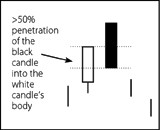
This two-candle formation is a top reversal pattern. The second black candle must penetrate 50 per cent or more into the white candle’s body. In candlestick philosophy, the more significant patterns display greater penetration of one candle into the body of another; therefore, this pattern is not as significant as the bearish engulfing pattern. Confidence is essential to ensure the continuation of an uptrend. The dark cloud cover suggests a loss of confidence by the bulls, and this may lead to a future downturn in trend.
8) The piercing pattern
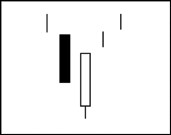
This two-candle bottom reversal pattern is the inverse of a dark cloud cover. The 50 per cent penetration level of the second candle into the body of the first is essential to fulfill the definition of this pattern.
9) The evening star
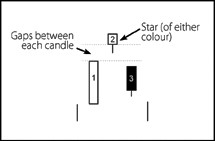
This bearish three-candle top reversal pattern shows a long white real body (1), a small star of either colour (2), then a black real body (3). The evening star pattern is especially significant if there are gaps between each candle.
10) The morning star
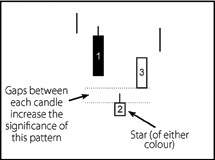
This bullish three-candle bottom reversal pattern shows a long black real body (1), a small star of either colour (2), then a white real body (3). If a bottom reversal pattern occurs within an existing medium-term uptrend, often the effect will be very bullish. However, a bottom reversal during a medium-term downtrend will not show such a vigorous bullish response.
How To Use Candlesticks
There are many other candlestick patterns that appear in Australian charts. Rather than memorising every definition, it is more important to internalise the meaning behind each pattern. The specifics of the formation of candlestick patterns may initially seem a little confusing.
To help simplify the use of candlesticks, try focusing on the following aspects:
- Candle colour: look at the chart, and see whether there are more white candles or more black candles. If there are more white candles, it is probable that the predominant emotion in the market is bullish. If there are more black candles, the bears are more likely to be in control of the bulls.
- Candle length: observe the length of the candles. Look at the real body length, as well as the length of the tails. If there are longer white candles, compared to black, then the bulls are in control. If the black candles are longer than the white, the bears are winning the battle. Roughly equal numbers of black and white candles means that the share is likely to be travelling in a sideways band, and neither the bulls nor the bears are dominating.
- Tail location: if there are lots of tails sticking upwards, this indicates selling pressure, and the share is likely to fall in value. If there are many tails pointing downwards, then the buyers are moving into the market and the share is likely to increase in value
Comments
Post a Comment